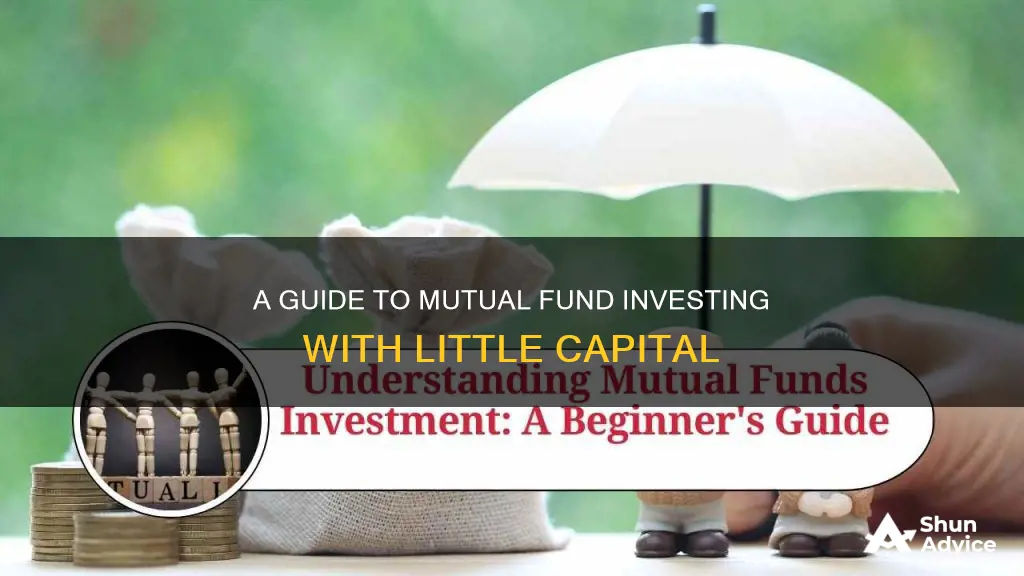
Investing in mutual funds is a great way to build a diversified portfolio without too much hassle or cost. They are ideal for investors who don't have the time or ability to choose individual stocks and are a good option for those with little money to start with.
1. Set an investing goal: Determine whether you are investing for the short-term or long-term. If it's the former, consider a savings account or money market fund. For long-term goals, such as retirement, mutual funds are a good option.
2. Decide on an account type: Choose between a standard brokerage account, a 401(k), a traditional IRA, or a Roth IRA.
3. Decide on the mix of stocks and bonds: Determine your asset mix based on your goals, time frame, and risk tolerance. If you are investing for the long-term, a stock-heavy allocation is generally recommended.
4. Pick an investment strategy: Choose between active funds, which aim to beat the market and come with higher fees, or passive funds, which aim to match the market and have lower fees.
5. Research mutual fund companies: Look into well-known companies like Vanguard or Fidelity, and consider factors such as regulatory issues and fund performance.
6. Research mutual funds: Evaluate funds based on fees, historical performance, and investment strategy.
7. Open an investing account: Set up a 401(k), taxable brokerage account, or IRA, depending on your previous choices.
8. Buy mutual fund shares: Some funds have investment minimums, so ensure you have enough money deposited in your account.
9. Be a good long-term investor: Avoid trying to time the market and focus on being a successful long-term investor.
10. Don't forget about taxes: Keep in mind that mutual funds can trigger capital gains taxes, and you may owe taxes on dividends or interest received.
By following these steps, you can start investing in mutual funds with a small amount of money and work towards your financial goals.
| Characteristics | Values |
|---|---|
| Investment type | Stocks, bonds, securities, commodities, real estate, money market, index funds, ETFs, etc. |
| Investment goal | Short-term, long-term, retirement, education, etc. |
| Investment strategy | Active, passive, or a mix of both |
| Investment account | Standard brokerage, 401(k), IRA, Roth IRA, etc. |
| Asset mix | Stocks, bonds, commodities, etc. |
| Fund provider | Vanguard, Fidelity, American Funds, etc. |
| Fund type | Passive, active, income, growth, value, etc. |
| Fund fees | Expense ratios, management fees, 12b-1 fees, load fees, redemption fees, account fees, etc. |
| Investment minimum | $0 to $3,000 |
| Investment style | Aggressive, conservative, etc. |
| Investment research | Fund screeners, SEC filings, fund fact sheets, etc. |
| Investment returns | Dividend payments, interest, capital gains, etc. |
What You'll Learn

Understand the different types of mutual funds
There are many different types of mutual funds available, and it can be confusing to navigate them all. Here are some of the more popular types of funds:
- Stock or equity mutual funds: These funds invest in corporate stocks and can also pursue different strategies from fund to fund. Some focus on companies that pay dividends and are well-established, while others focus on growth and the potential for price appreciation. Still, others are focused on specific industries, sectors, or geographies.
- Bond mutual funds: These funds invest in various forms of debt, and their risk profiles can vary widely from fund to fund. Some will invest in relatively safe bonds issued by governments, while others invest in riskier "junk" bonds that offer higher potential returns.
- Money market mutual funds: These funds tend to be low-risk and earn a small return above that of a normal savings account. Money market funds invest in high-quality short-term debt issued by companies and governments.
- Index mutual funds: These funds track the performance of an index such as the S&P 500 and are usually able to keep costs low. Studies have shown that this passive approach outperforms active management over long time periods in most cases.
Other types of mutual funds include:
- Target-date funds: These funds automatically reallocate your asset mix as you age and are a good choice for investors who don't want to actively manage their portfolio.
- Income funds: These funds are meant to disburse income on a steady basis and are often seen as mutual funds for retirement investing. They invest primarily in government and high-quality corporate debt, holding these bonds until maturity to provide interest streams.
- International mutual funds: These funds invest only in assets located outside an investor's home country.
- Regional mutual funds: These funds focus on a specific geographic region, such as a country, continent, or group of countries with similar economic characteristics.
- Sector and theme mutual funds: These funds aim to profit from the performance of specific sectors of the economy, such as finance, technology, or healthcare.
- Socially responsible mutual funds: These funds invest only in companies and sectors that meet preset criteria, such as companies that do not operate in the tobacco, alcoholic beverages, weapons, or nuclear power industries.
Mutual Funds vs. ETFs: Pros, Cons, and Your Investment Choice
You may want to see also

Set an investment goal
Setting an investment goal is the first step in investing in mutual funds. This involves identifying what you are investing for and what your financial goals are. For instance, you may be saving for a secure retirement, planning to buy a home, or saving for your child's education.
If you are investing for the short term, it is generally recommended to skip stock and bond mutual funds as these are more volatile and can be risky. Instead, opt for a short-term vehicle like a savings account or money market fund. An exception to this is if you are investing for current income, in which case an income fund, which is made up of income-producing assets like dividend stocks, bonds, and real estate, may be more suitable.
On the other hand, if you are investing for the long term, mutual funds can be a good option. With a longer time frame, your portfolio will be better able to weather the stock market's periodic losses. Over the long term, the S&P 500, an index of the market's 500 largest stocks, has offered an average annual return of about 8% per year.
When setting investment goals, it is also important to consider your risk tolerance. If you are investing for retirement and have a long time horizon, you may opt for a more aggressive, stock-heavy allocation. On the other hand, if you are closer to retirement, you may want to have a more substantial allocation of bonds in your portfolio to reduce risk.
Additionally, it is crucial to align your investment goals with the appropriate time frame. For example, if you are investing for retirement 30 years in the future, you can choose a more aggressive, stock-heavy mutual fund compared to someone investing to buy a yacht in five years. Generally, the shorter your time horizon, the more conservative your mutual fund selection should be.
In summary, setting clear and defined investment goals is a crucial first step in investing in mutual funds. This involves understanding your financial objectives, time horizon, and risk tolerance to make informed decisions about the types of mutual funds that align with your goals.
IRA Investment Strategies: Where to Invest for Maximum Returns
You may want to see also

Decide on an account type
There are several account options for investing in mutual funds, and the right one for you will depend on your specific goals. Here are some of the most common types of accounts you can use to invest in mutual funds:
- Standard brokerage account: These accounts can be easily opened through an investment company or bank and allow you to invest in a wide range of securities, including stocks, bonds, and mutual funds. Examples of standard brokerage accounts include Fidelity and TD Ameritrade.
- 401(k): These tax-advantaged retirement accounts are commonly offered by employers as part of their benefits packages. Mutual funds are typically the most common investment option within 401(k) plans.
- Traditional Individual Retirement Account (IRA): If your employer doesn't offer a retirement savings plan, you can consider opening a traditional IRA. These accounts offer tax advantages and can be opened at most investment companies.
- Roth IRA: Roth IRAs are another option for saving for retirement. They are funded with after-tax dollars, allowing your contributions to grow tax-free.
When choosing an account type, it's important to consider your investment goals, tax advantages, and the level of risk you're comfortable with. Each account type has its own set of benefits and features, so it's essential to understand your options before making a decision.
Tax Managed Mutual Funds: When to Invest for Maximum Benefits
You may want to see also

Choose a brokerage account
When investing in mutual funds, you have a few options for where to buy them. You can choose to buy directly from the company that created the fund, such as Vanguard or BlackRock, but this will limit your choice of funds. You can also work with a traditional financial advisor to purchase funds, but this may incur additional fees.
Most investors opt to buy mutual funds through an online brokerage, which offers a broad selection of funds from a range of companies. When choosing a brokerage account, there are several factors to consider:
- Affordability: Mutual fund investors can face two types of fees: transaction fees from the brokerage account and expense ratios and sales loads from the funds themselves. Be sure to understand all the fees associated with a brokerage account before signing up.
- Fund choices: Some brokerages offer a wider variety of funds to choose from than others. Consider whether you want access to a large number of funds or if you are content with a more limited selection.
- Research and educational tools: With a greater choice of funds comes the need for more research. Choose a brokerage that provides comprehensive information and tools to help you make informed decisions about your investments.
- Ease of use: The brokerage's website or app should be user-friendly and easy to navigate. Make sure you feel comfortable with the platform before committing to it.
- Fidelity: Offers a wide range of funds, including active and passive options, as well as tools for trading stocks and other investments.
- TD Ameritrade: A good choice for beginners, with a variety of investment options.
- Vanguard: One of the largest retirement plan providers in the US, offering accounts such as 401(k)s and IRAs, as well as a wide range of funds.
- American Funds: Focuses primarily on mutual funds, with actively managed growth-and-income funds and balanced funds that combine stocks, bonds, and cash equivalents.
International Company Funds: Where to Invest Your Money
You may want to see also

Research fees
Researching fees is an important step in choosing a mutual fund to invest in. Fees can significantly impact your investment returns over time, so it's crucial to understand the different types of fees associated with mutual funds. Here are some common fees to look out for:
- Expense ratio: This is an annual fee that covers the fund's operating expenses, including management fees, administrative costs, and marketing expenses. The expense ratio is expressed as a percentage of the fund's average net assets and is deducted from the fund's returns. According to the Investment Company Institute, the average expense ratio for equity mutual funds has decreased from 1.04% in 1996 to 0.44% in 2022. Bond mutual funds had a slightly lower average of 0.37%, while hybrid models had expense ratios of 0.59%.
- Sales charges or loads: Some mutual funds charge sales fees, known as "loads," when you buy or sell shares. Front-end loads are charged when you purchase shares, while back-end loads are assessed if you sell your shares before a certain date. No-load funds, on the other hand, don't have any commission or sales charges.
- Redemption fees: Some mutual funds charge a redemption fee when you sell your shares shortly after purchasing them (usually within 30 to 180 days). This fee is intended to discourage short-term trading and maintain stability in the fund. The U.S. Securities and Exchange Commission (SEC) limits redemption fees to 2%.
- Other account fees: In addition to the fees mentioned above, some funds or brokerage firms may charge extra fees for maintaining your account or transactions, especially if your account balance falls below a certain minimum.
- Management and distribution fees: Mutual funds may also charge management fees to compensate the fund managers for their services, as well as distribution fees (also known as 12b-1 fees) for marketing and distributing the fund. These fees are included in the expense ratio but are worth noting as they can impact the overall cost of the fund.
When researching mutual funds, it's important to carefully review the fund's prospectus, which outlines all the fees and expenses associated with the fund. By comparing the expense ratios and other fees across different funds, you can make a more informed decision about which fund offers the best value for your investment goals. Remember that lower fees can result in higher overall returns over time, so it's crucial to consider the cost structure of a mutual fund before investing.
Invest Your 403(b) in Index Funds: A Comprehensive Guide
You may want to see also
Frequently asked questions
Mutual funds may have higher investment minimums than other asset classes. For example, Vanguard's minimum investment for actively managed mutual funds is $3,000. However, some funds have a 0 minimum, and you can invest in a mutual fund for as little as $1.
Mutual funds are ideal for investors who don't have the time or ability to choose individual stocks. They are actively managed by fund managers and are therefore a great option for hands-off, passive investors. They are also highly liquid and known for their affordability, accessibility and low barrier of entry.
There are thousands of mutual funds to choose from, so having a checklist of factors to consider is important. Firstly, you should determine your investment goal and time frame. If you're investing for retirement 30 years in the future, you can choose a more aggressive (stock-heavy) mutual fund than someone investing with a five-year time frame. You should also consider the fund's fees, performance and fund managers.







